Yamaha 25A, 30A Manual
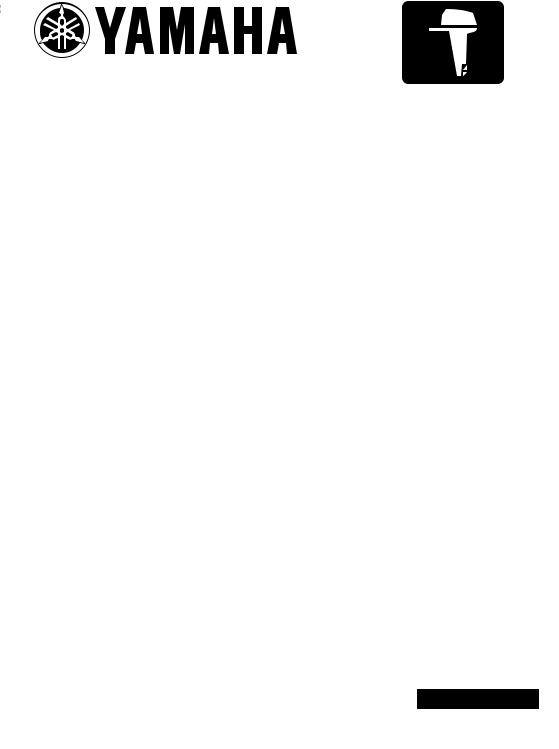
OWNER’S MANUAL
U.S.A.Edition
LIT-18626-04-54
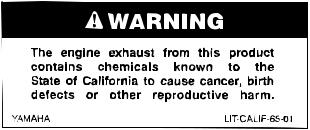
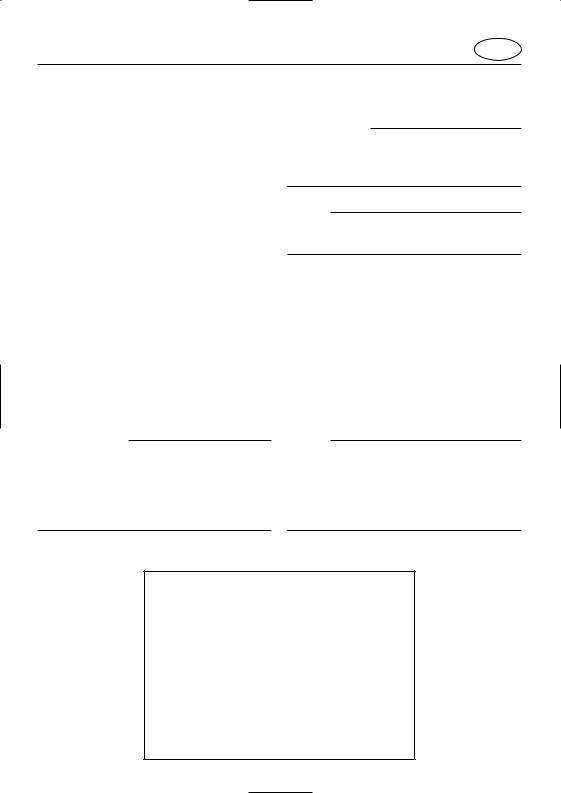
E
EMU01449
TO THE OWNER
Thank you for choosing a Yamaha out- cC
board motor. This Owner’s manual contains information needed for proper oper-
A CAUTION indicates special precautions
ation, maintenance and care. A thorough
that must be taken to avoid damage to
understanding of these simple instructions will help you obtain maximum enjoyment from your new Yamaha. If you have any question about the operation or maintenance of your outboard motor, please consult a Yamaha dealer.
the outboard motor.
In this Owner’s Manual particularly important information is distinguished in the following ways.
The Safety Alert Symbol means
QATTENTION! BECOME ALERT!
YOUR SAFETY IS INVOLVED!
w
Failure to follow WARNING instructions could result in severe injury or death to the machine operator, a bystander, or a person inspecting or repairing the outboard motor.
EMU01446
25A/30A OWNER'S MANUAL
©2001 by Yamaha Motor Corporation, USA 1st Edition, April 2001
All rights reserved.
Any reprinting or unauthorized use without the written permission of Yamaha Motor Corporation, USA is expressly prohibited.
Printed in Japan
P/N LIT-18626-04-54


EMA20010
CONTENTS |
E |
|
1
BASIC COMPONENTS
OPERATION
MAINTENANCE
TROUBLE RECOVERY
INDEX
2
3
4
5
6
THIS OWNER’S MANUAL CAREFULLY OPERATING YOUR OUTBOARD MOTOR.

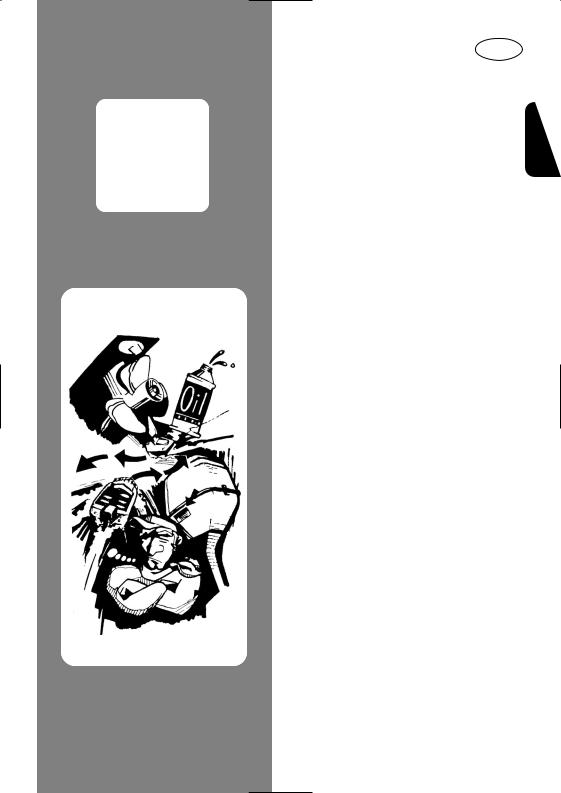
E
1
IDENTIFICATION NUMBERS RECORD ..1-1 2
Outboard motor serial number |
...........1-1 |
3
4
5
6
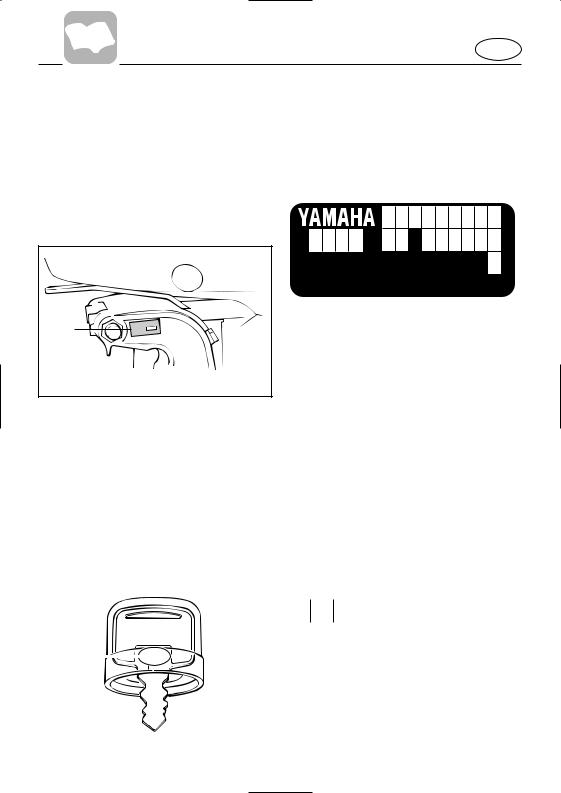
E
EMU00005
IDENTIFICATION NUMBERS
RECORD
EMU00007
OUTBOARD MOTOR SERIAL NUMBER
1 |
401012 |
YAMAHA MOTOR CO., LTD. MADE IN JAPAN
PAYS D'ORIGINE JAPON
The outboard motor serial number is stamped on the label attached to the port side of the clamp-bracket.
Record your outboard motor serial number in the spaces provided to assist you in ordering spare parts from your Yamaha dealer or for reference in case your outboard motor is stolen.
1 Outboard motor serial number
|
|
|
|
|
|
|
|
EMU00008 |
|
|
|
|
|
|
|
|
|
KEY NUMBER |
|
|
|
YAMAHA |
|
||||||
|
|
|
|
|
|
||||
|
|
|
|
|
|
||||
|
|
|
|
If a main key switch is equipped with the |
|||||
q |
|
|
123 |
|
|
motor, the key identification number is |
|||
|
|
|
|
stamped on your key as shown in the |
|||||
|
|
|
|
|
|
|
|
||
|
|
|
|
|
|
||||
|
|
|
|
|
|
|
|
illustration. Record this number in the |
|
|
|
|
|
|
|
||||
|
|
|
|
|
|
|
|
space provided for reference in case you |
|
|
|
|
|
|
|
904011* |
|
need a new key. |
|
|
|
|
|
|
|
|
1 Key number |
||
|
|
|
|
|
|
|
|
||
|
|
|
|
|
|
|
|
||
|
|
|
|
|
|
1-1 |
|
||
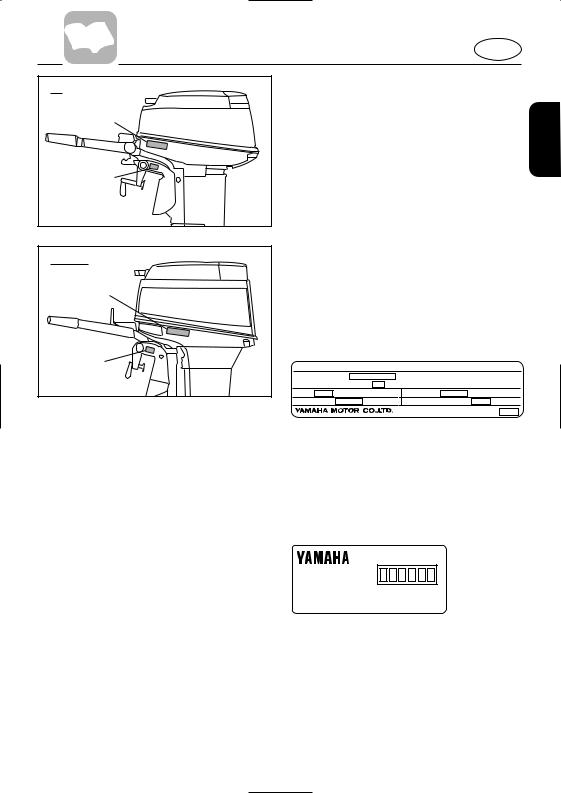
25 |
1 |
2 |
108021 |
25-3/30 |
1 |
2 |
108022 |
EMU01385
EMISSION CONTROL
INFORMATION
EMU01386
NORTH AMERICAN MODELS
This engine conforms to U.S. Environmental Protection Agency (EPA) regulations for marine SI engines. See the label affixed to your engine for details.
Approval label of Emission control certificate
This label is attached to the bottom cowling.
1 Emission control information label
EMISSION CONTROL INFORMATION
ENGINE FAMILY :
THIS ENGINE CONFORMS TO 2001 U.S. EPA REGULATIONS FOR MARINE SI ENGINES.
FELs : |
g/kw-hr |
IDLE SPEED : |
rpm IN NEUTRAL |
SPARK PLUG : |
|
SPARK PLUG GAP (mm) : |
|
Existing Technology ; N/A
Manufactured date label
This label is attached to the clamp bracket or the swivel bracket.
2 Manufactured date label
Manufactured:
1-2

E
EMU00917
QINFORMATIONSAFETY
8Before mounting or operating the outboard motor, read this entire manual. Reading it should give you an understanding of the motor and its operation.
8Before operating the boat, read any owner’s or operator’s manuals supplied with it and all labels. Be sure you understand each item before operating.
8Do not overpower the boat with this outboard motor. Overpowering the boat could result in loss of control. The rated power of the outboard should be equal to or less than the rated horsepower capacity of the boat. If the rated horsepower capacity of the boat is unknown, consult the dealer or boat manufacturer.
8Do not modify the outboard. Modifications could make the motor unfit or unsafe to use.
8Never operate after drinking alcohol or taking drugs. About 50% of all boating fatalities involve intoxication.
8Have an approved personal flotation device (PFD) on board for every occupant. It is a good idea to wear a PFD whenever boating. At a minimum, children and non-swimmers should always wear PFDs, and everyone should wear PFDs when there are potentially hazardous boating conditions.
8Gasoline is highly flammable, and its vapors are flammable and explosive. Handle and store gasoline carefully. Make sure there are no gas fumes or leaking fuel before starting the engine.
8This product emits exhaust gases which contain carbon monoxide, a colorless, odorless gas which may cause brain damage or death when inhaled. Symptoms include nausea, dizziness, and drowsiness. Keep cockpit and cabin areas well ventilated. Avoid blocking exhaust outlets.
8Check throttle, shift, and steering for proper operation before starting the engine.
8Attach the engine stop switch lanyard to a secure place on your clothing, or your arm or leg while operating. If you accidentally leave the helm, the lanyard will pull from the switch, stopping the engine.
8Know the marine laws and regulations where you will be boating - and obey them. Refer to the “RULES OF THE ROAD” section for basic boating rules.
8Stay informed about the weather. Check weather forecasts before boating. Avoid boating in hazardous weather.
8Tell someone where you are going: leave a Float Plan with a responsible person. Be sure to cancel the Float Plan when you return.
8Use common sense and good judgment when boating. Know your abilities, and be sure you understand how your boat handles under the different boating conditions you may encounter. Operate within your limits, and the limits of your boat. Always operate at safe speeds, and keep a careful watch for obstacles and other traffic.
8Always watch carefully for swimmers during the engine operation.
8Stay away from swimming areas.
1-3
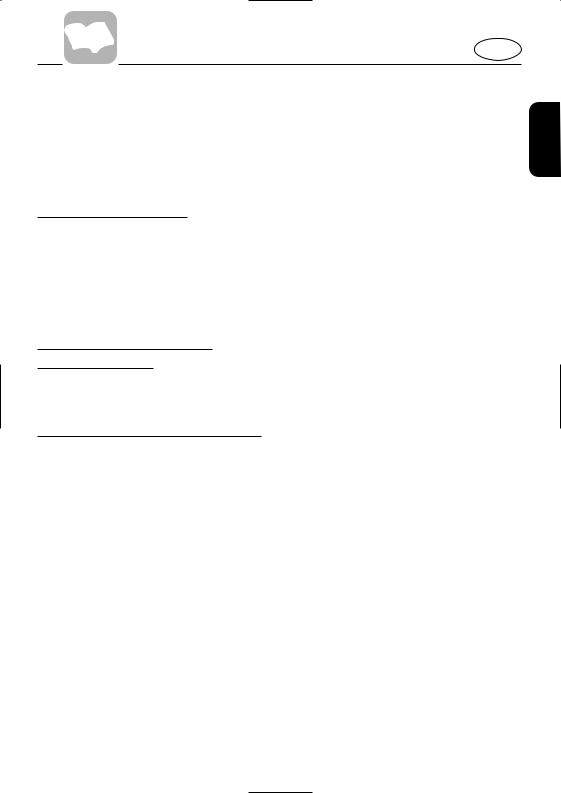
8When a swimmer is in the water near you shift into neutral and shut off the engine.
8Be informed about boating safety. Additional publications and information can be obtained from many organizations, including the following:
United States Coast Guard
Consumer Affairs Staff (G-BC)
Office of Boating, Public, and Consumer
Affairs
U.S. Coast Guard Headquarters
Washington, D.C. 20593-0001
Boating Safety Hotline: 1-800-368-5647
National Marine Manufacturers
Association (NMMA)
401 N. Michigan Ave.
Chicago, Il 60611
Marine Retailers Association of America
155 N. Michigan Ave.
Chicago, Il 60601
1-4

E
LOCATION |
|
25 |
|
q |
|
w |
|
|
202023 |
25-3/30 |
q |
w |
|
|
202061 |
30 |
|
|
q |
|
202062 |
EMB30010
IMPORTANT LABELS
WARNING LABELS
1
WARNING
●Be sure shift control is in neutral before starting engine. (except 2HP)
●Do not touch or remove electrical parts when starting or during operation.
●Keep hands,hair,and clothes away from flywheel and other rotating parts while engine is running.
6A1-83625-41
2
WARNING
This engine is equipped with a neutral starting device. The engine will not start unless the shift control is
in neutral position.
6E0-83627-41
1-5
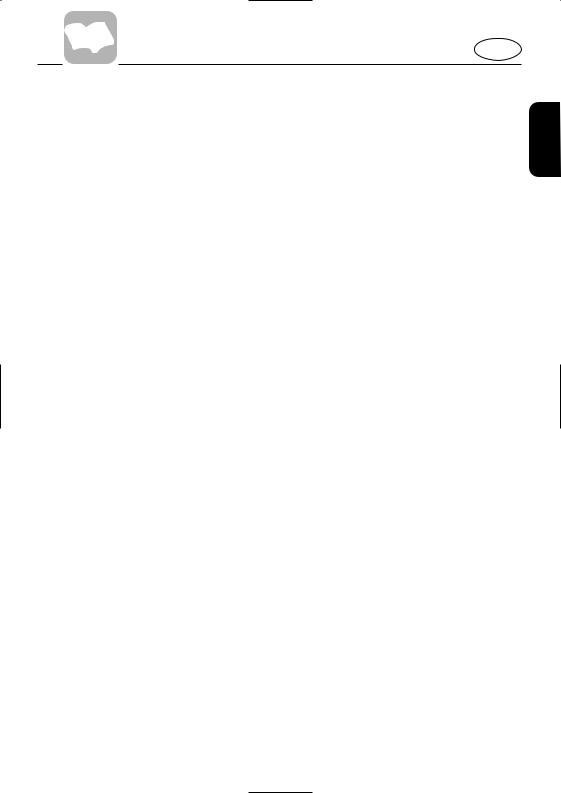
EMB40010
BASIC BOATING RULES (Rules of the road)
Just as there are rules which apply when you are driving on streets and high ways, there are waterway rules which apply when you are driving your boat. These rules are used internationally, and are also enforced by the United States Coast Guard and local agencies. You should be aware of these rules, and follow them whenever you encounter another vessel on the water.
Several sets of rules prevail according to geographic location, but are all basically the same as the International Rules of the Road. The rules presented here in your Owner’s Manual are condensed, and have been provided for your convenience only. Consult your local U.S. Coast Guard Auxiliary or Department of Motor Vehicles for a complete set of rules governing the waters in which you will be using your boat.
STEERING AND SAILING RULES AND SOUND SIGNALS
Whenever two vessels on the water meet one another, one vessel has the right-of- way; it is called the “stand-on” vessel. The vessel which does not have the right- of-way is called the “give-way” or “burdened” vessel. These rules determine which vessel has the right-of-way, and what each vessel should do.
Stand-on vessel
The vessel with the right-of-way has the duty to continue its course and speed, except to avoid an immediate collision. When you maintain your direction and speed, the other vessel will be able to determine how best to avoid you.
Give-way vessel
The vessel which does not have the right- of-way has the duty to take positive and timely action to stay out of the way of the Stand-On vessel. Normally, you should not cross in front of the vessel with the right-of-way. You should slow down or change directions briefly and pass behind the other vessel. You should always move in such a way that the operator of the other vessel can see what you are doing.
“The general prudential rule”
This rule is called Rule 2 in the International Rules and says,
‘In obeying and construing these rules due regard shall be had to all dangers of navigation and collision, and to any special circumstances, which may render a departure from the above rules necessary in order to avoid immediate danger.’
In other words, follow the standard rules except when a collision will occur unless both vessels try to avoid each other. If that is the case, both vessels become “Give-Way” vessels.
1-6
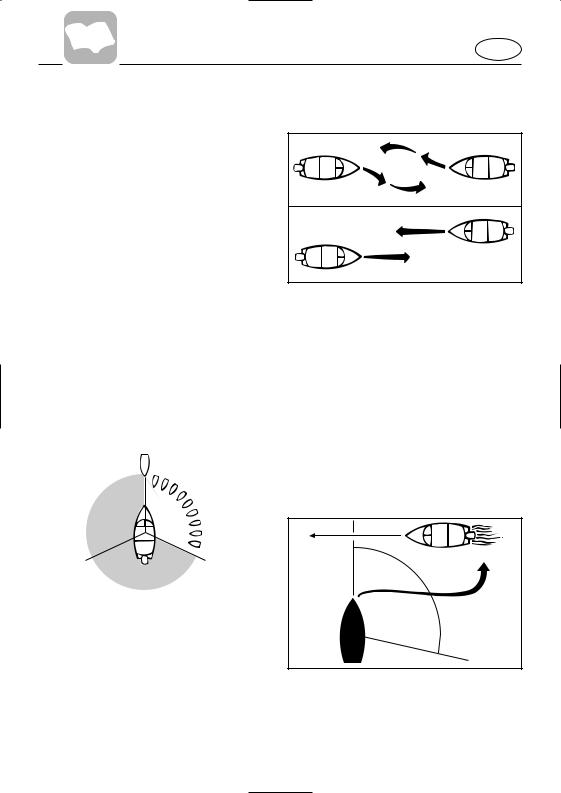
E
RULES |
ENCOUNTERING |
|
There |
main situations which you |
|
may |
with other vessels which |
|
could |
collision unless the Steer- |
|
ing |
|
|
Meeting |
are |
approaching another |
vessel |
|
|
Crossing |
are |
travelling across the |
other |
|
|
|
are passing or being |
|
passed |
vessel) |
|
In the |
illustration, your boat is |
|
in the |
should give the right-of- |
|
way |
|
shown in white area |
(you |
-Way vessel). Any ves- |
|
sels |
|
area must yield to you |
(they |
-Way vessels). Both you |
|
and |
vessel must alter course |
|
to |
|
. |
|
102045 |
|
|
Meeting |
|
If you |
another power vessel |
head |
close enough to run the |
risk |
neither of you has the |
right |
Both of you should alter |
course |
an accident. You should |
keep |
vessel on your port (left) |
side. This rule doesn’t apply if both of you will clear one another if you continue on your set course and speed.
102044
Crossing
When two power driven vessels are crossing each other’s path close enough to run the risk of collision, the vessel which has the other on the starboard (right) side must keep out of the way of the other. If the other vessel is on your right, you must keep out of its way; you are the Give-Way vessel. If the other vessel is on your port (left) side, remember that you should maintain course and direction, provided the other vessel gives you the right-of-way as it should.
102046
Overtaking
If you are passing another vessel, you are the “Give-Way” vessel. This means that
1-7
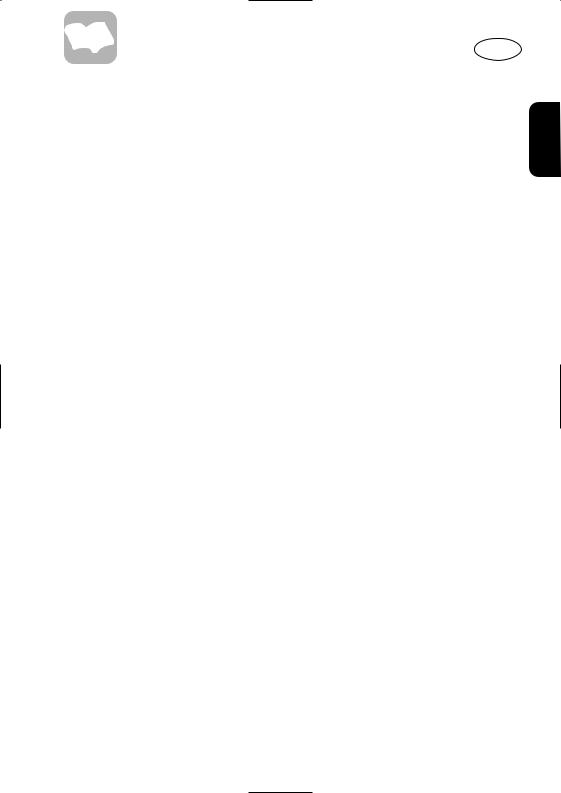
|
|
|
|
E |
the |
is expected to maintain |
Sailing vessel right-of-way |
||
its |
speed. You must stay out |
Sailing vessels should normally be given |
||
of its |
you are clear of it. Like- |
the right-of-way. The exceptions to this |
||
wise, |
vessel is passing you, you |
are: |
|
|
should |
your speed and direction |
1. |
When the sailing vessel is overtaking |
|
so |
vessel can steer itself |
|
the power-driven vessel, the power- |
|
around |
|
|
driven vessel has the right-of-way. |
|
|
|
|
2. |
Sailing vessels should keep clear of |
OTHER |
SITUATIONS |
|
any fishing vessel. |
|
There |
other rules you should be |
3. |
In a narrow channel, a sailing vessel |
|
aware |
driving your boat around |
|
should not hamper the safe passage |
|
other |
|
|
of a power-driven vessel which can |
|
|
|
|
|
navigate only in such a channel. |
Narrow |
and bends |
When |
in narrow channels, you |
should |
the right when it is safe |
and |
do so. If the operator of a |
power |
vessel is preparing to go |
around |
that may obstruct the view |
of |
vessels, the operator |
should |
a prolonged blast on the |
whistle |
seconds). If another vessel |
is |
bend, it too should sound |
the |
if no reply is heard, |
|
vessel should still proceed |
around |
with caution. If you navi- |
gate |
with your boat, you will |
need |
a portable air horn, avail- |
able |
marine supply stores. |
Fishing |
right-of-way |
|
All |
are |
fishing with nets, |
lines |
are considered to be “fish- |
|
ing |
under |
the International |
Rules |
with trolling lines are not |
|
|
vessels. Fishing ves- |
|
sels |
right-of-way regardless of |
|
position |
vessels cannot, howev- |
|
er, |
passage of other vessels in |
|
narrow |
. |
|
Reading buoys and other markers
The waters of the United states are marked for safe navigation by the lateral system of buoyage. Simply put, buoys and markers have an arrangement of shapes, colors, numbers and lights to show which side of the buoy a boater should pass on when navigating in a particular direction. The markings on these buoys are oriented from the perspective of being entered from seaward (the boater is going towards the port). This means that red buoys are passed on the starboard (right) side when proceeding from open water into port, and black buoys are to port (left) side. When navigating out of port, your position with respect to the buoys should be reversed; red buoys should be to port and black buoys to starboard.
Many bodies of water used by boaters are entirely within the boundaries of a particular state. The Uniform State Waterway Marking System has been devised for these waters. This system uses buoys and signs with distinctive shapes and colors to show regulatory or advisory informa-
1-8
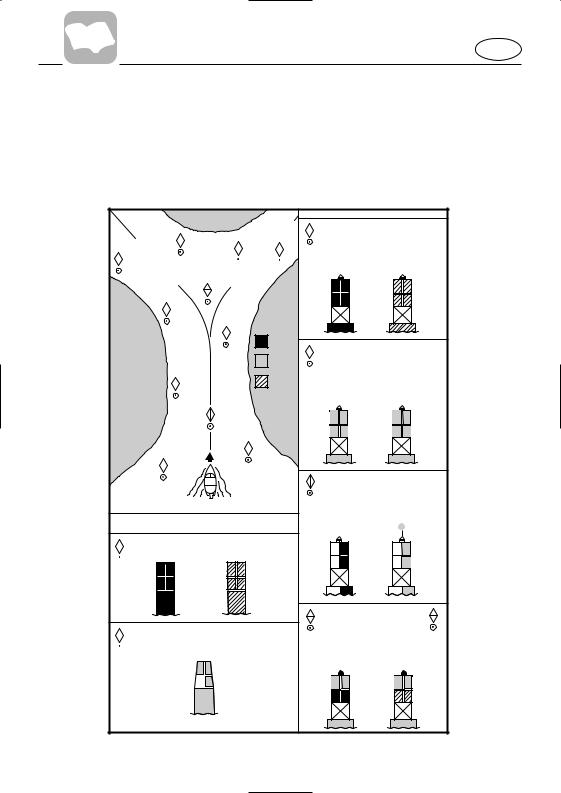
tion. These markers are white with black letters and orange boarders. They signify speed zones, restricted areas, danger areas, and general information.
Remember, markings may vary by geographic location. Always consult local boating authorities before driving your boat in unfamiliar waters.
|
|
|
|
|
|
|
|
|
|
|
|
|
|
|
|
|
|
|
|
L |
|
|
|
|
|
|
|
|
|
|
|
|
|
|
|
|
|
|
|
N |
E |
|
|
|
|
|
|
" 6" |
|
|
|
|
|
|
|
|
|
|
|
N |
|
|
|
|
|
|
|
|
|
|
|
|
|
|
|
|
|
|
A |
|
|
||
|
M |
|
|
|
|
|
|
|
|
|
C " 1" |
|
CH |
|
N " 2" |
|||||
|
|
|
|
|
|
|
|
|
|
|
|
|
||||||||
|
A |
|
|
|
|
|
|
|
|
|
|
|
|
|
|
|
|
|
|
|
" 7" |
IN |
|
|
|
|
|
|
|
|
|
|
|
AR |
Y |
|
|
|
|
|
|
|
C |
|
|
|
RB |
" L" |
|
|
|
|
|
|
|
|
|
|
|
|||
|
|
|
|
|
|
|
|
|
|
|
|
|
|
|
|
|
||||
|
|
HA |
|
|
or |
|
|
|
|
|
N |
D |
|
|
|
|
|
|
|
|
|
|
|
NN |
|
|
|
|
C |
O |
|
|
|
|
|
|
|
|
|||
|
|
|
|
RG |
" L" |
|
|
|
|
|
|
|
|
|
|
|
||||
|
|
|
|
EL |
S |
E |
|
|
|
|
|
|
|
|
|
|
||||
|
|
|
|
|
|
|
|
|
|
|
|
|
|
|
|
|
||||
|
|
|
|
|
" 5" |
|
|
|
|
|
|
|
|
|
|
|
|
|
|
|
|
|
|
|
|
|
|
|
|
|
|
|
|
|
|
|
BUOY |
|
|||
|
|
|
|
|
|
|
|
" 4" |
|
|
|
|
COLOR CODE |
|||||||
|
|
|
|
|
|
|
|
|
|
|
|
|
|
|
|
|
|
|
||
|
|
|
|
|
|
|
|
|
|
|
|
|
|
|
|
BLACK |
||||
|
|
|
|
|
|
|
|
|
|
|
|
|
|
|
|
RED |
|
|||
|
|
|
|
|
|
" 3" |
|
|
|
|
|
|
|
|
|
GREEN |
||||
|
|
|
|
|
|
|
|
|
|
|
|
|
|
|
|
|||||
|
|
|
|
|
|
|
" A" |
|
|
|
|
|
|
|
|
|
|
|
|
|
|
|
|
|
|
|
|
|
|
|
|
|
|
" 2" |
|
|
|
|
|
||
|
|
|
|
" 1" |
|
|
|
|
|
|
|
|
|
|
|
|
|
|
|
|
|
|
|
|
|
|
Proceeding toward head |
|
|
|
|
|
|
|
|
|
|
|
|||
|
|
|
|
|
of navigation from seaward |
|
|
|
|
|
|
|
|
|
|
|||||
|
|
SECONDARY CHANNEL BUOYS |
|
|
|
|
||||||||||||||
|
|
|
STARTS NEW NUMBERING SYSTEM |
|
|
|
|
|
|
|||||||||||
C " 1" |
|
|
|
|
CAN BUOY |
|
|
|
|
|
|
|
|
|
|
|
|
|
||
|
|
|
Odd number. Leave to port. |
|
|
|
|
|
|
|
|
|
|
|
|
|
||||
1 |
1 |
|
OR |
old |
new |
N " 2" |
NUN BUOY |
|
|
|
Even number. Leave to starboard |
 2
2
No change
E
MAIN CHANNEL BUOYS
" 1" " 3" " 5" " 7"
LIGHTED BUOY (Port Hand)`
Odd number. increasing toward head of navigation.Leave to port (left) proceeding upstream.
White Light |
Green Light |
1 |
1 |
OR |
|
old |
new |
" 2" " 4" " 6"
LIGHTED BUOY (Starboard Hand)`
Even number,increasing toward head of navigation. Leave to starboard (right) proceeding upstream.
White Light |
Red Light |
2 |
2 |
OR |
|
old |
new |
" A"
LIGHTED SAFE WATER BUOY
No number. Marks midchannel, pass on either side. Letter has no lateral significance, used for identification and location purposes.
|
Top Mark |
White Light |
White Light |
A |
A |
OR |
|
old |
new |
RB " L" |
RG " L" |
LIGHTED PREFERRED CHANNEL TO
PORT BUOY
No number . Topmost band red - preferred channel is to left of buoy. Letter has no lateral significance, used for identification and location purposes.
|
Red or |
Red Light |
|
|
White Light |
||
L |
L |
||
|
|||
old |
|
new |
102052
1-9
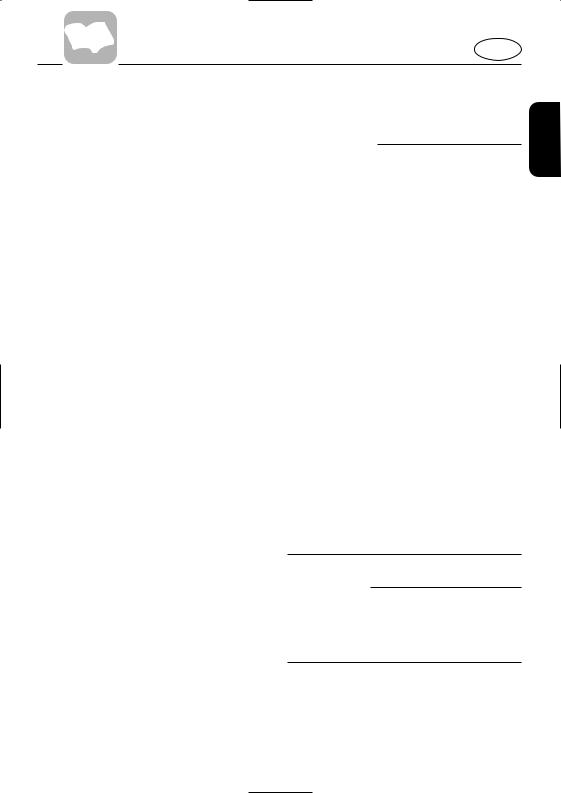
E
EMU00016
FUELING INSTRUCTIONS
w
GASOLINE AND ITS VAPORS ARE HIGHLY FLAMMABLE AND EXPLOSIVE!
8Do not smoke when refueling, and keep away from sparks, flames, or other sources of ignition.
8Stop engine before refueling.
8Refuel in a well-ventilated area. Refuel portable fuel tanks off the boat.
8Take care not to spill gasoline. If gasoline spills, wipe it up immediately with dry rags.
8Do not overfill the fuel tank.
8Tighten the filler cap securely after refueling.
8If you should swallow some gasoline inhale a lot of gasoline vapor, or get gasoline in your eyes, get immediate medical attention.
8If any gasoline spills onto your skin, immediately wash with soap and water. Change clothing if gasoline spills on it.
8Touch the fuel nozzle to the filler opening or funnel to help prevent electrostatic sparks.
cC
Use only new clean gasoline which has been stored in clean containers and is not contaminated with water or foreign matter.
1-10
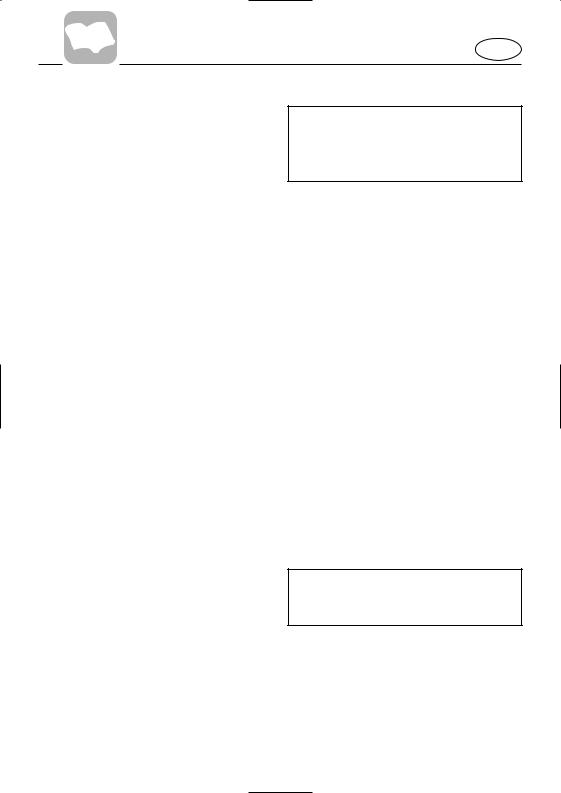
E
EMU00018
GASOLINE (PETROL)
Recommended gasoline: Regular unleaded gasoline with a minimum octane rating of 86
(Pump Octane Number) = (R+M)/2
If knocking or pinging occurs, use a different brand of gasoline or premium unleaded fuel. If unleaded gasoline is not available, then leaded regular gasoline can be used.
EMU00027
Gasohol
There are two types of gasohol: gasohol containing ethanol and that containing methanol. Gasohol containing ethanol can be used if ethanol content does not exceed 10% and the fuel meets minimum octane ratings. Gasohol containing methanol is not recommended by Yamaha because it can cause fuel system damage or engine performance problems.
EMU00858
ENGINE OIL
Recommended engine oil: YAMALUBE 2 STROKE OUTBOARD OIL
If the recommended engine oil is not available, another 2-stroke engine oil with a NMMA-certified TC-W3 rating may be used.
1-11
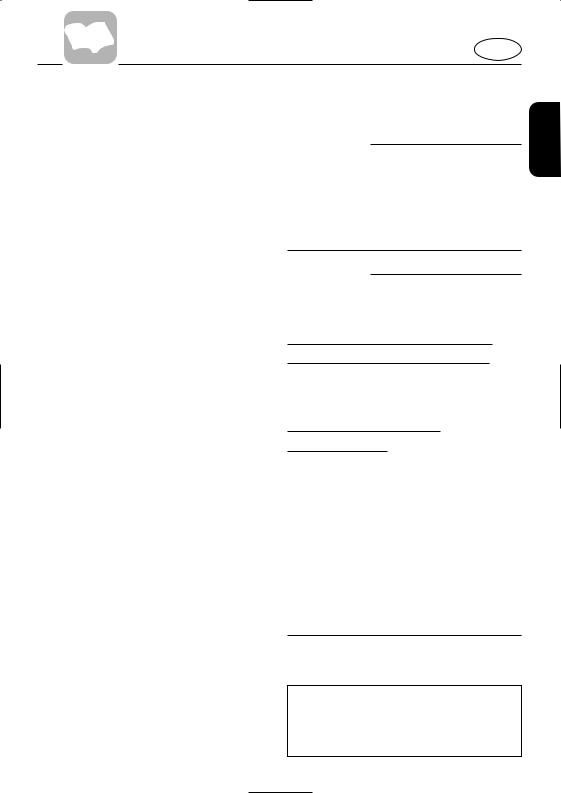
E
EMU01430
BATTERY REQUIREMENT
cC
Do not use a battery that does not meet the specified capacity. If a battery which differs from the specification is used, the electrical system may perform poorly or be overloaded, causing electrical system damage.
cC
8A battery cannot be connected to models which do not have a rectifier or rectifier regulator.
Models without a rectifier or rectifier
regulator: 25NMH, 30DMHO, 25JMH
8If you wish to use a battery with the above models, install an optional rectifier regulator.
Models with only a rectifier
installed: 30DEHO
8Using a maintenance-free battery with the above models can shorten the life of the battery significantly.
8Use caution when connecting accessories such as fish finders, as they may be damaged by high voltage. Install an optional rectifier regulator or use accessories rated to withstand 18 volts or higher with the above models. Consult your Yamaha dealer for details on installing an optional rectifier regulator.
Choose a battery for electric start models which meets the following specifications.
Minimum cold crank performance 210 Amps at -17.8°C (0°F) Minimum reserve capacity
40 minutes at 26.7°C (80°F)
1-12
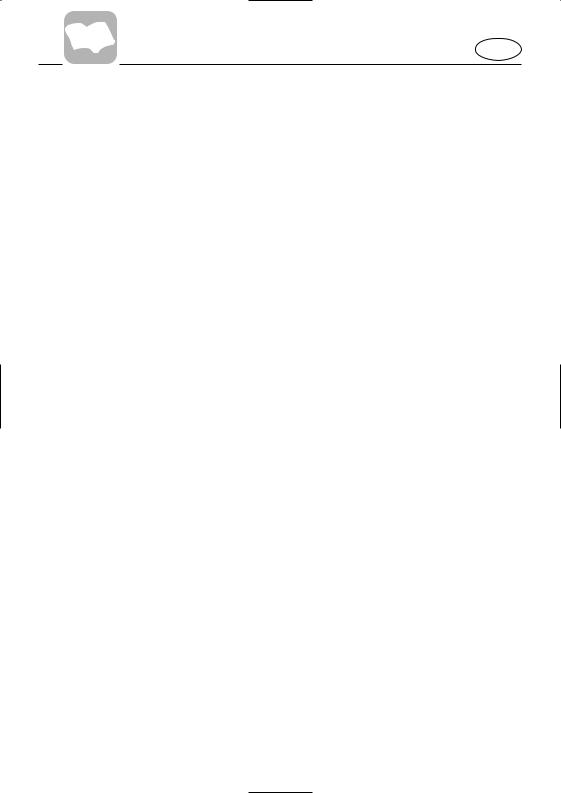
E
EMU01395
PROPELLER SELECTION
The performance of your outboard motor will be critically affected by your choice of propeller, as an incorrect choice could adversely affect performance and could also seriously damage the motor. Engine speed depends on the propeller size and boat load. If engine speed is too high or too low for good engine performance, this will have an adverse effect on the engine.
Yamaha outboard motors are fitted with propellers chosen to perform well over a range of applications, but there may be uses where a propeller with a different pitch would be more appropriate. For a greater operating load, a smaller-pitch propeller is more suitable as it enables the correct engine speed to be maintained. Conversely, a larger-pitch propeller is more suitable for a smaller operating load.
Yamaha dealers stock a range of propellers, and can advise you and install a propeller on your outboard that is best suited to your application.
1-13

10-3/4x17-F
1 23
E
NOTE:
At full throttle and under a maximum boat load, the engine’s rpm should be within the upper half of the full throttle operating range, as listed in “SPECIFICATIONS” on page 4-1. Select a propeller which fulfills this requirement.
If operating under conditions which allow the engine’s rpm to rise above the maximum recommended range (such as light boat loads), reduce the throttle setting to maintain the rpm in the proper operating range.
1 Propeller diameter (in inches)
2 Propeller pitch (in inches)
3 Type of propeller (propeller mark)
Refer to the section “CHECKING PRO- 602016 PELLER” for instructions on propeller
removal and installation.
EMU01209
START-IN-GEAR PROTECTION
Yamaha outboard motors or Yamaha approved remote control units are equipped with start-in-gear protection device(s). This feature permits the engine to be started only when it is Neutral. Always select Neutral before starting the engine.
1-14
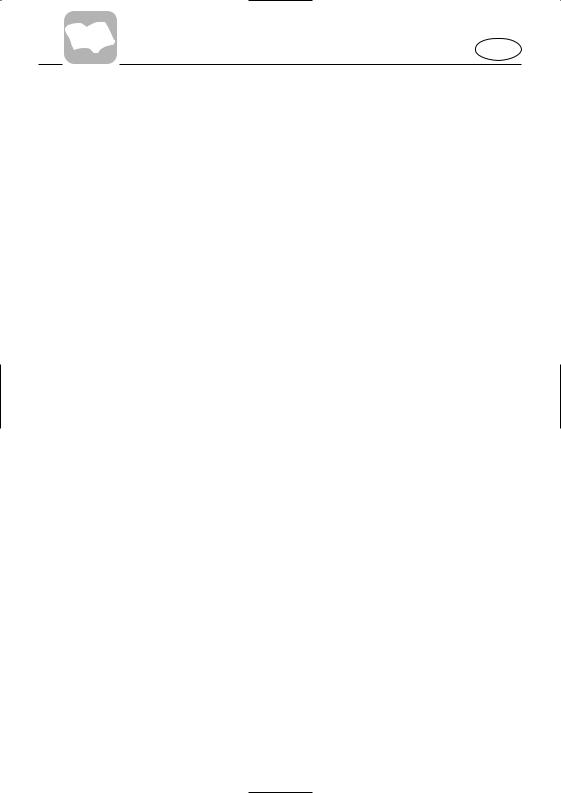
E
-MEMO-
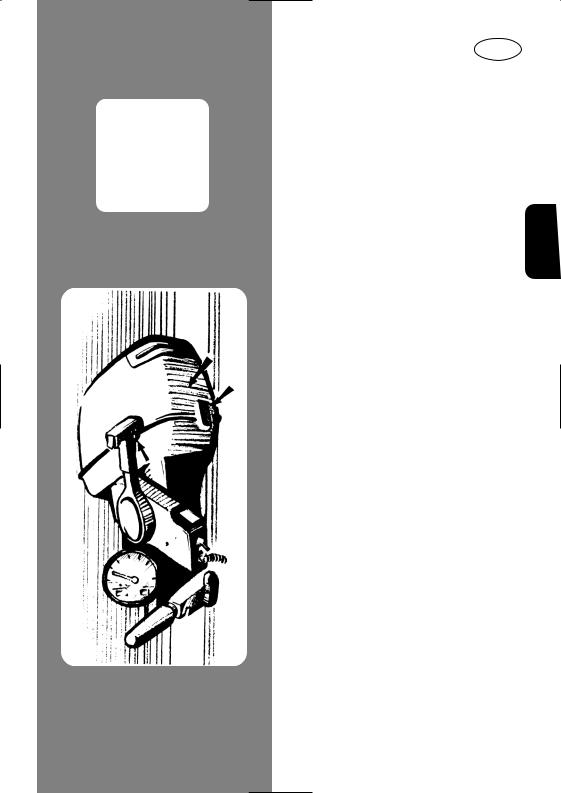
E
1
MAIN COMPONENTS.............................. |
2-1 |
2 |
OPERATIONS OF CONTROLS AND |
|
|
OTHER FUNCTIONS ................................ |
2-3 |
|
|
|
3 |
4
5
6
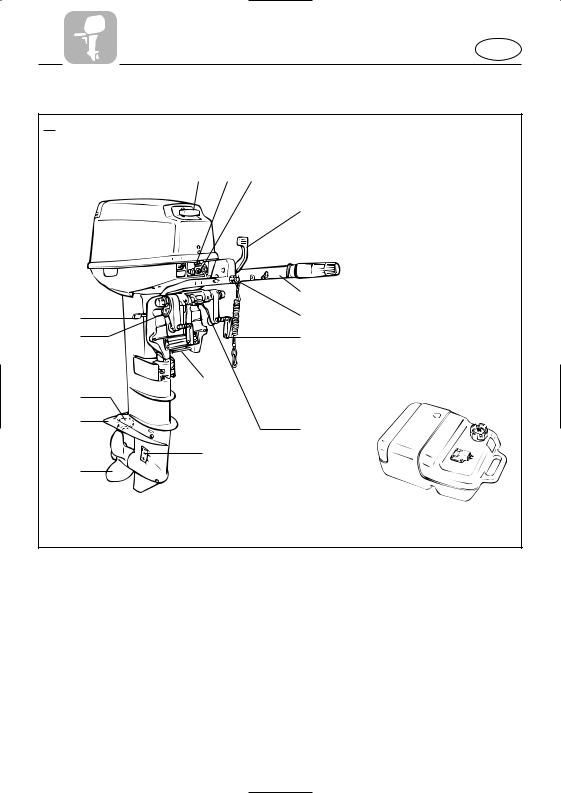
EMU01206
MAIN COMPONENTS
25 |
|
|
|
q w e |
|
|
|
r |
|
|
t |
!5 |
|
y |
!4 |
|
u |
|
!3 |
!6 |
!2 |
|
|
|
|
|
!1 |
|
i |
|
|
|
|
o |
|
!0 |
|
|
|
101061 |
|
1 Recoil starter handle
2 Choke knob
3 Warning lamp
4 Gear shift lever
5 Throttle-control grip/Tiller-handle
6Engine stop button/ Engine stop lanyard switch
7 Transom-clamp handle
8 Tilt lock lever
9 Cooling water inlet
0 Propeller
q Trim tab (Anode) w Anti-cavitation plate
e Trim angle adjusting-rod r Rope attachment
t Shallow water lever
yFuel tank
*May not be exactly as shown; also may not be included as standard equipment on all models.
2-1
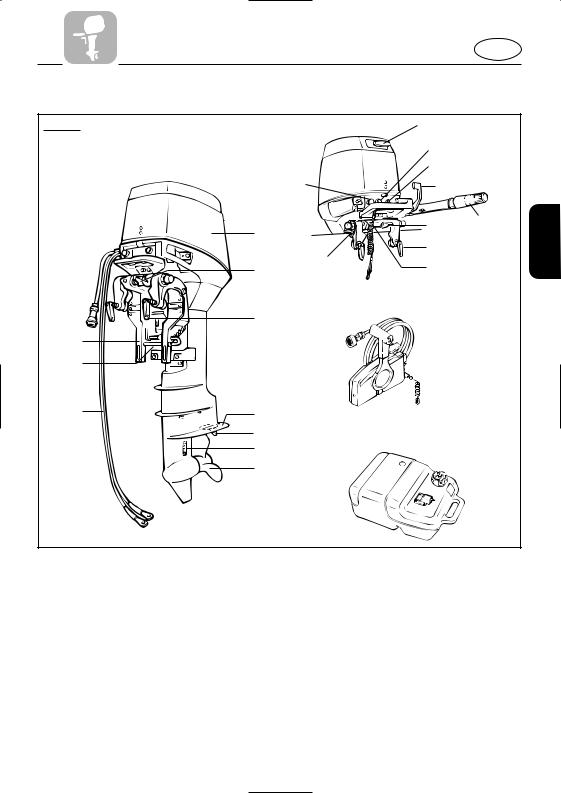
E
EMU01206
MAIN COMPONENTS
25-3/30 |
|
|
!2 |
|
|
|
|
!3 |
|
|
|
|
!4 |
|
|
|
!9 |
!5 |
|
|
q |
|
w |
!6 |
|
|
|
||
|
|
|
|
|
|
|
|
e |
|
|
w |
!8 |
!7 |
|
|
|
101113** |
||
|
|
|
|
|
!1 |
|
|
|
|
|
e |
@0 |
|
|
|
|
|
|
|
!0 |
|
|
|
|
o |
|
|
|
|
i |
|
|
701061 |
|
r |
|
|
|
|
|
|
|
|
|
|
t |
@1 |
|
|
|
y |
|
|
|
|
|
|
|
|
|
u |
|
|
|
|
101111 |
|
|
|
1 Top cowling |
e Engine stop button/Engine stop lanyard |
2 Tilt-lock lever |
switch |
3 Transom-clamp handle |
r Warning lamp |
4 Anti-cavitation plate |
* t Gear shift lever |
5 Trim tab |
* y Throttle-control grip/tiller handle |
6 Cooling water inlet |
* u Shallow water lever |
7 Propeller |
* i Rope attachment |
* 8 Battery lead |
* o Choke knob |
9 Trim angle adjusting rod |
* p Remote control box |
0 Clamp bracket |
* a Fuel tank |
q Wiring harness |
|
* w Recoil starter handle |
* May not be exactly as shown; also may not |
|
be included as standard equipment on all |
|
models. |
2-2
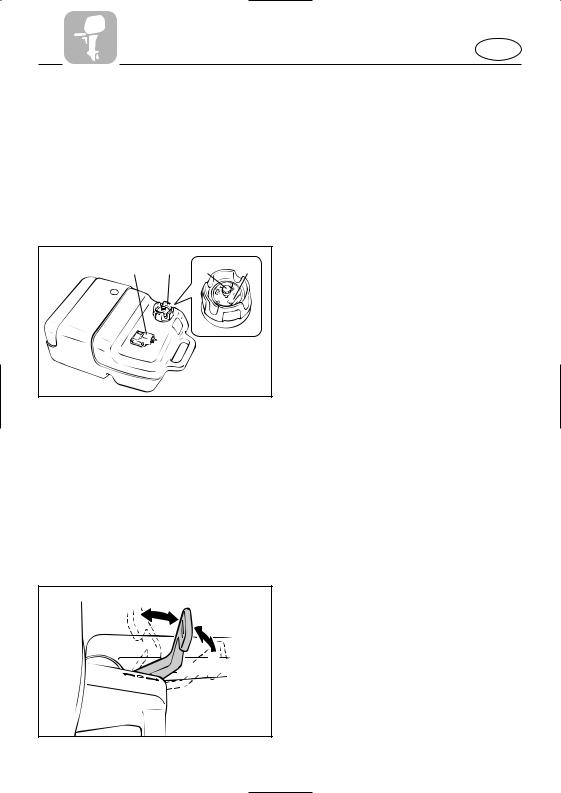
E
q |
e |
r |
w |
|
|
|
902051 |
EMC20010
OPERATIONS OF CONTROLS AND OTHER FUNCTIONS
EMC21012
FUEL TANK
If your model was equipped with a portable fuel tank, its function is as follows.
1 Fuel hose joint
2 Fuel meter(If equipped)
3 Fuel tank cap
4 Air vent screw(If equipped)
Fuel hose joint
This connector is provided for connecting or disconnecting fuel hose.
Fuel meter
This meter is on the fuel tank cap. It shows current fuel quantity in the fuel tank approximately.
e
 q
q







 w
w
406015
Fuel tank cap
This cap is for filling fuel. To remove it, turn it counterclockwise.
Air Vent screw
This screw is on the fuel tank cap. To loosen it, turn it counterclockwise.
EMC25010
GEAR SHIFT LEVER (for Tiller control model)
Turning the gear-shift lever towards you engages the clutch with the forward gear so that the boat moves ahead. Turning the lever away from you engages the reverse gear so that the boat moves astern.
1 Neutral
2 Forward
3 Reverse
2-3
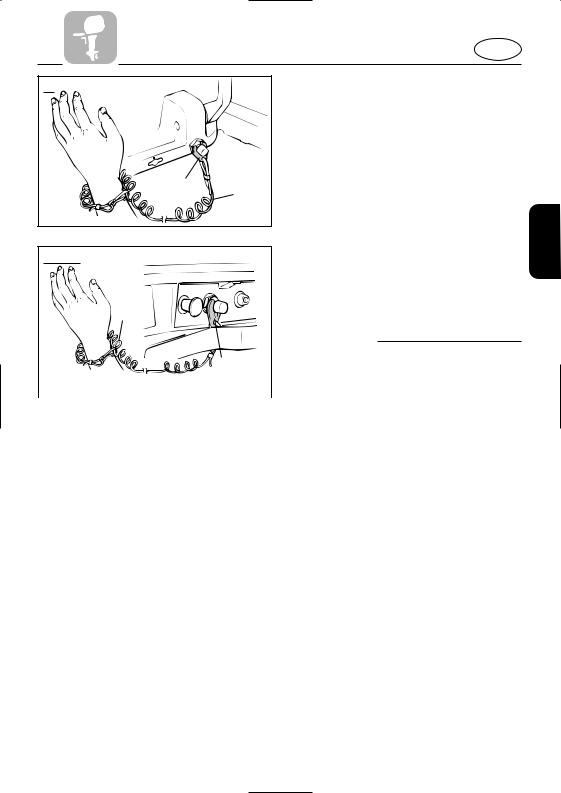
|
|
E |
|
25 |
|
EMC28111 |
|
|
ENGINE STOP LANYARD SWITCH |
||
|
|
||
|
|
(for Tiller control model) |
|
|
|
The lock-plate on the end of the lanyard |
|
|
|
must be attached to the engine stop |
|
|
|
switch for the engine to run. The lanyard |
|
1 |
|
should be attached to a secure place on |
|
2 |
the operator’s clothing, or arm or leg. |
||
|
|||
|
001127 |
Should the operator fall overboard or |
|
|
leave the helm, the lanyard will pull out |
||
|
|
||
|
|
the lock plate, stopping ignition to the |
|
25-3/30 |
|
engine. This will prevent the boat from |
|
|
|
running away under power. |
|
w |
|
1 Lock-plate |
|
|
2 Lanyard |
w
q |
8Attach the engine stop switch lanyard |
||
|
|
to a secure place on your clothing, your |
|
001126 |
|
arm or leg while operating. |
|
|
|
8Do not attach the lanyard to clothing |
|
|
|
||
|
|
that could tear loose. Do not route the |
|
|
|
lanyard in such a way that it could |
|
|
|
become entangled, preventing it from |
|
|
|
functioning. |
|
|
|
8Avoid accidentally pulling the lanyard |
|
|
|
during normal operation. Loss of |
|
|
|
engine power means the loss of most |
|
|
|
steering control. Also, without engine |
|
|
|
power, the boat could slow rapidly. |
|
|
|
This could cause people and objects in |
|
|
|
the boat to be thrown forward. |
|
|
|
|
|
|
|
NOTE: |
|
|
|
The engine cannot be started with the |
|
|
|
lock-plate removed. |
|
|
|
|
|
2-4
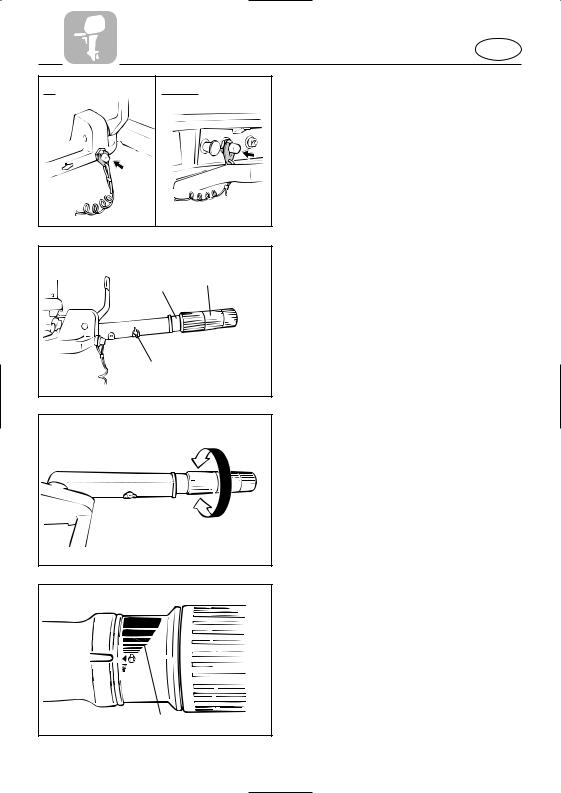
E
25 |
25-3/30 |
|
3 |
w |
q |
|
|
e |
|
|
503021* |
|
503032 |
q |
503022** |
EMC27011
ENGINE STOP BUTTON (for Tiller control model)
Pushing this button opens the ignition circuit and stops the engine.
EMU00062
TILLER HANDLE (for Tiller control model)
Moving the tiller handle sideways to adjust the steering direction. In addition, this handle contains the functions as follows.
1 Throttle control grip
2 Throttle indicator
3 Throttle friction adjusting knob/screw
EMU00065
Throttle Control Grip
The throttle control grip is on the tiller handle. Turn the grip counterclockwise to increase speed and clockwise to decrease speed.
EMU00067
Throttle Indicator
The fuel consumption curve on the throttle indicator shows the relative amount of fuel consumed for each throttle position. Choose the setting that offers the best performance and fuel economy for the desired operation.
1 Throttle indicator
2-5
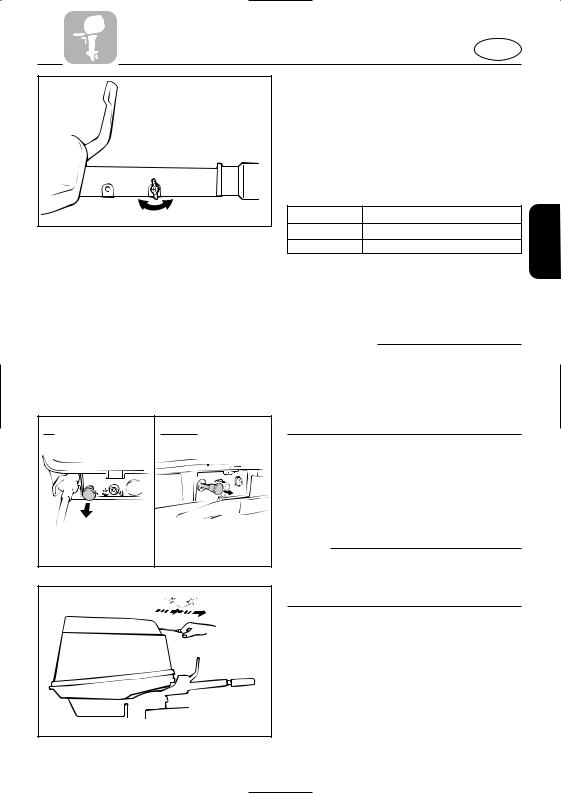
E
502011 |
EMU01293
Throttle friction adjusting screw/ knob
A friction device in the tiller handle provide resistance to movement of the throttle grip.
This is adjustable for operator preference. An adjusting screw/knob is located within the tiller handle.
Resistance |
Knob/Screw |
Increase |
Turn clockwise |
Decrease |
Turn counterclockwise |
When constant speed is desired, tighten the adjusting screw/bolt to maintain the desired throttle setting.
25 |
|
25-3/30 |
|
305022* |
305023* |
|
|
209015 |
w
Do not over tighten the friction adjusting screw/ knob.
If there is too much resistance, it may be difficult to move the throttle grip, which could result in an accident.
EMC42010
CHOKE KNOB
Pulling out this knob (setting it to ON) supplies a rich mixture required to start the engine.
NOTE:
The choke knob for Remote control model has the same function as the choke switch on the remote control box.
EMC44010
RECOIL STARTER HANDLE (If equipped)
Pull the handle gently until resistance is felt. Then vigorously pull the handle straight out to crank the engine to start it.
2-6
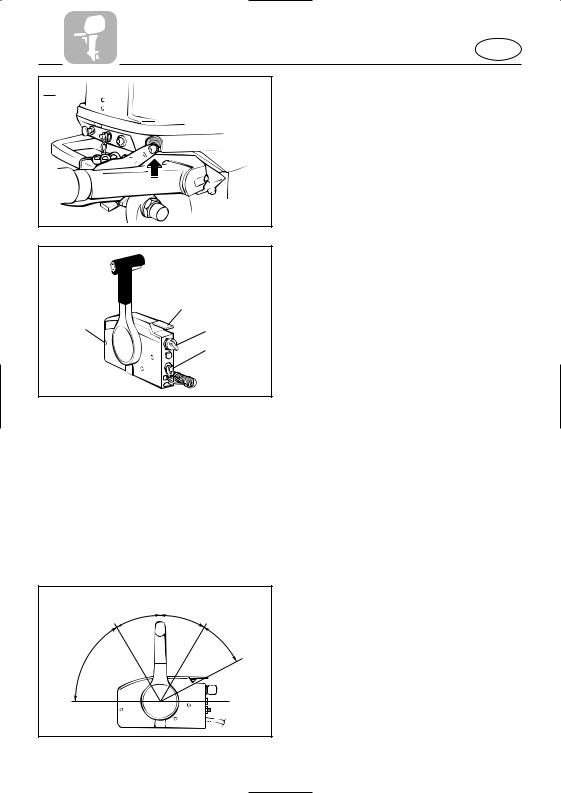
E
30 |
306014 |
EMC46010
STARTER BUTTON (for Tiller control model)
When you push the starter button, the electric starter motor cranks the engine to start it.
EMU00090
q
 w
w
e
y |
r |
|
t |
000893
wF r N q r Re
|
t t |
y |
y |
u |
|
|
|
|
|
u |
|
REMOTE CONTROL
Both the shifter and the throttle are actuated by the remote control lever. In addition, this remote control also has the electrical switches.
1 Remote control lever
2 Neutral interlock trigger
3 Neutral throttle lever
4 Main switch / Choke switch
5 Engine stop lanyard switch
6 Throttle friction adjusting screw
Remote control lever
Moving the lever forward from the Neutral position engages Forward gear. Pulling the lever back from Neutral engages Reverse. The engine will continue to run at idle until the lever is moved about 35° (a detent can be felt). Moving the lever farther opens the throttle, and the engine will begin to accelerate.
1 Neutral
2 Forward
3 Reverse
4 Shift
5 Fully closed
6 Throttle
7 Fully open
2-7
